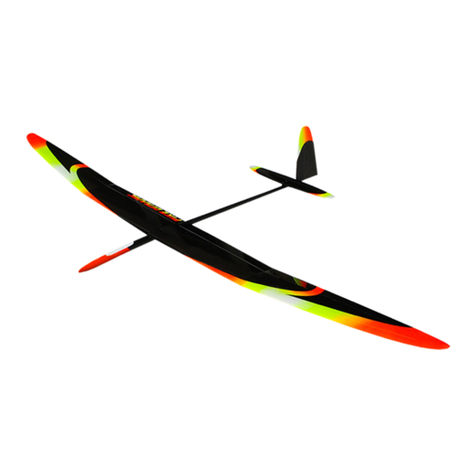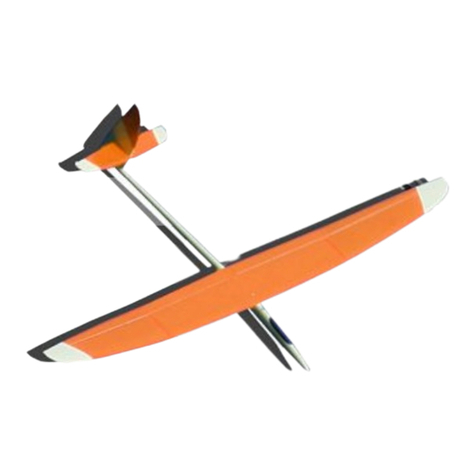
Servos and receiver installed in fuse
Mount elevator and rudder and secure in neutral with some tape. Shorten the rod
for correct length by marking the total length to servo horn with a pen and then
pull forward thru opening for cutting. The coupler can be glued to the carbon rod
with Cyano and for safety pinch the coupler with a plier to ensure tight fit. Check
the connection thoroughly
Adjust the elevator so that it is in neutral checking top and bottom airfoil (trailing
edge 24mm from fuse). Full throw is 15mm up and 17mm down. At full crow the
elevator goes down to approximately 11mm depending on crow settings for wing.
It is good to ensure more down throw (+6mm) possible after crow brake is set
Adjust rudder throw to 30mm +/-
Using excess of of 40mm might slow down the model instead of yaw motion
Fuse installation on youtube by Flightcomp: https://youtu.be/xG_r3nwUsmw
Assembling the model:
Attach the rudder to the fuse and insert the screw provided to secure the rudder.
Secure with a tiny piece of tape round the front part. Carefully push the ball link
in place and check that they move freely. Pinch the plastic with a plier to free
them up if they are tight. The ball link can be removed by using a flat screwdriver
clicking it off again.
Screw on the elevator and be sure the pushrod pin is inserted before.
Screw on midsection wing and plug in the tips with the included joiners inserted
first in the tips completely inserted.
Attach the tips with clear tape to secure at top and around leading edge.
Check and adjust the CG (center of gravity). A suitable CG to start off is 110mm
for all conditions and 112mm from leading edge in calm conditions
Check range according to transmitter specifications.
If you can not get the necessary range you need to:
1) Check antenna locations
2) Try another transmitter
3) Try another receiver
Settings:
All the latest detailed settings can be found on www.F3J.com.
These are settings from some of the world’s best pilots.
You will find these setting a very good starting point.
Wings cannot stay in the sun without wing covers. Covers prevent excessive heating of
the model as there could appear some deformations of model parts when model is
overheated, or the surface could get distortions. If the reflex painted parts are not
protected against the sun, the reflex effect will fade much earlier even if there is used
layer of paint with UV filter.
Prestige 2PK specifications are without any guarantee for structural stiffness. Sudden
changes in the deflection of the controls at high speeds are also prohibited.
The model is intended for F5J competition flying and not for aerobatics.
After harder landings it is necessary to check the joiner and look for cracks as it could
cause failure of complete model in the next flights.

























